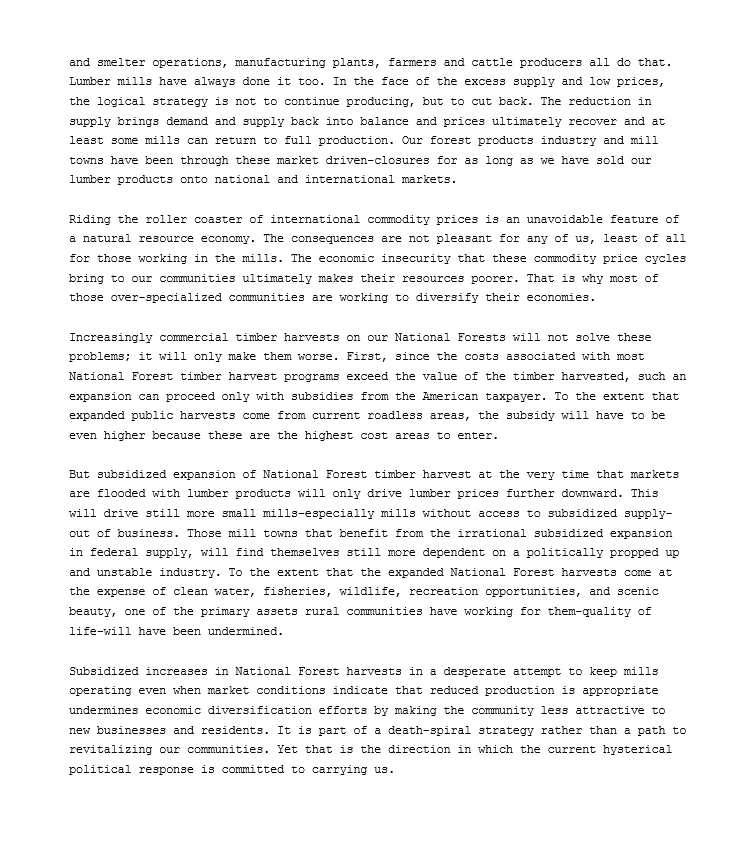B ECON
In 2003 the following article was written by Thomas Michael Power, ' Why are Lumber Mills Really Shutting Down'? Please read the article below and explain both in words and with clearly drawn graphs what is causing some of these mills to shut down. You may assume that prior to lumber prices falling that the firms were operating at a zero economic profit long run equilibrium. Also, is the author correct in his claim that accessing National Forest timber will make the situation worse? Justify your answer using graphs and explain clearly what is going on in your graphs what is happening. When drawing your graphs, clearly label them (both the curves and the variables on the axes
1. In EDGE the following article was written by Thomas Michael Power, ' Why are Lumber Hills Really Shutting Down'? Please read the article below and explain both in words and with clearly drawn graphs what is causing some of these mills to shut down. You may assume that prior to lumber prices fallind that the firms were operating at a zero economic profit long run equilibrium. Also, is the author correct in his claim that accessing National Forest timber will make the situation worse? Justify your answer using graphs and explain clearly what is going on in your graphs what is happening. When drawing your graphs, clearly label them {both the curves and the variables on the axes}. It seems that with each passing week another of our small lumber mills shuts down, putting rural folks out of work. The timber industry and their political allies are quick to blame Rational Forest Policies and environmentalists for these mill shutdowns. But that is political hyperbole that is far off the economic mark. The shutdowns are not tied to an inadequate log supply, but rather to an excess supply of lumber prodncts on the market. Those are almost opposite problems. The nation is awash in lumber products. That surplus supply has driven prices down to ten year lows. Those low product prices are putting older, smaller, highrcost mills out of business. Those record low lumber prices are partly a result of American lumber mill capacity actually increasing significantly over the last five years as large, modernizing mills have expanded and new mills have been built. Those low prices are also tied to Canadian, European, and Latin American wood imports successfully competing with American mulls Blaming local environmental policies for changes that are driven by national and international competitive markets demonstrates either economic ignorance or self interested scapegoating. we should demand better of both our political and business leaders. Lumber mills are shutting down across the nation and a given mill's dependence on National Forest timber appears to have little to do with it. In Maine, where there is almost no dependence on Rational Forest timber, mills are closing and timberdependent counties are losing population. In California, Sierra Pacificthe largest private timberland owner in the stateannounced last January the shutdown of three of its mills. Sierra Pacific pointed to the plummeting lumber prices and honestly explained \" It just doesn't make sense to be cutting up highrvalue logs and then selling the lumber at low prices'. He in the East should be used to industrial firms responding to overesupply and low prices by temporarily cutting back or shutting down. Aluminum plants, paper mills, mine and smelter operations, manufacturing plants, farmers and cattle producers all do that. Lumber mills have always done it too. In the face of the excess supply and low prices, the logical strategy is not to continue producing, but to cut back. The reduction in supply brings demand and supply back into balance and prices ultimately recover and at least some mills can return to full production. Our forest products industry and mill towns have been through these market drivenclosures for as long as we have sold our lumber products onto national and international markets. Riding the roller coaster of international commodity prices is an unavoidable feature of a natural resource economy. The consequences are not pleasant for any of us, least of all for those working in the mills. The economic insecurity that these commodity price cycles bring to our communities ultimately makes their resources poorer. That is why most of those overspecialized communities are working to diversify their economies. Increasingly commercial timber harvests on our National Forests will not solve these problems; it will only make them worse. First, since the costs associated with most National Forest timber harvest programs exceed the value of the timber harvested, such an expansion can proceed only with subsidies from the American taxpayer. To the extent that expanded public harvests come from current roadless areas, the subsidy will have to be even higher because these are the highest cost areas to enter. But subsidized expansion of National Forest timber harvest at the very time that markets are flooded with lumber products will only drive lumber prices further downward. This will drive still more small millsespecially mills without access to subsidized supply out of business. Those mill towns that benefit from.the irrational subsidized expansion in fEderal supply, will find themselves still more dependent on a politically propped up and unstable industry. To the extent that the expanded Rational Forest harvests come at the expense of clean water, fisheries, wildlife, recreation opportunities, and scenic beauty, one of the primary assets rural communities have working for thenhguality of lifewill have been undermined. Subsidized increases in national Forest harvests in a desperate attempt to keep mills operating even when market conditions indicate that reduced production is appropriate undexndnes economic diversification efforts by making the community less attractive to new businesses and residents. It is part of a deathrspiral strategy rather than a path to revitalizing our mmmmudties. Yet that is the direction in which the current hysterical political response is committed to carrying us








